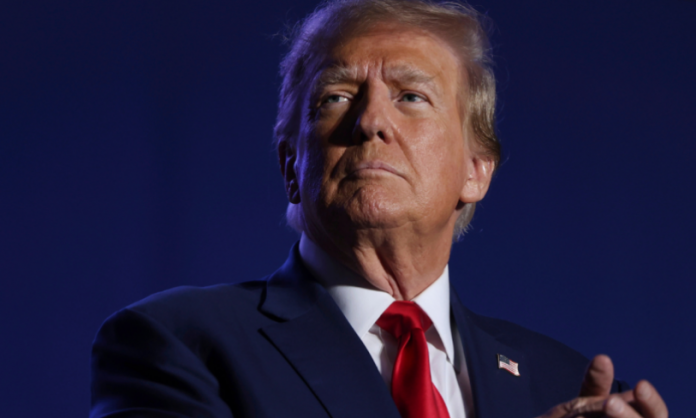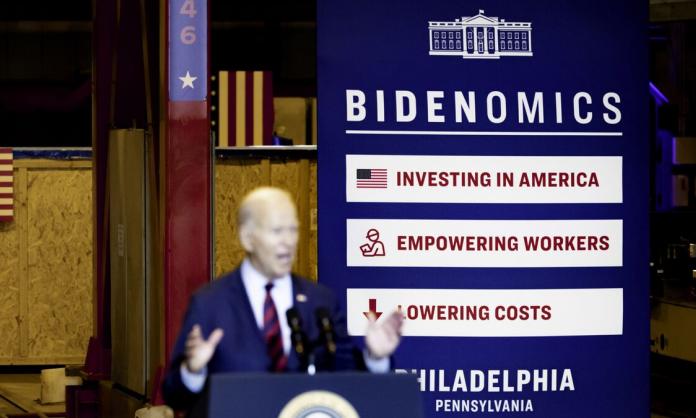The signing of US President Joe Biden’s $1.9 trillion American Rescue Plan Act—the country’s latest suite of pandemic relief measures—was met with liberal media reviews of a kind usually reserved for Hollywood foreign press acclamations of a Spielberg biopic.
“Democrats deserve a victory lap”, the New York Times editorial board said. Columbia University historian Adam Tooze, writing at Foreign Policy, described it as the “dawn of a new era” and a “triumph”. The Guardian called it “a historic moment”. The subsequent announcement of an estimated $3 trillion infrastructure and investment plan, the full details of which are yet to be released, was praised by Seth Hanlon, a senior fellow at the Center for American Progress, as “stunning” and led liberal columnist Jonathan Freedland to label Biden “a transforming radical”.
That bourgeois politics is mostly staged theatrics makes these responses somewhat apt. Democrats and their sympathisers have a political incentive to dramatise the new administration’s plans as akin to a great transformation—a new era that will radically alter the lives of working-class people across the United States. After all, the congressional midterm elections are next year, and the party is desperate to defend its wafer-thin majorities in the House and the Senate.
But there are two intertwined questions here, one of which relates to the significance of the new policies, the other to their adequacy when measured against the crises affecting US workers.
There is no doubt a shift going on in US ruling-class thinking about how to restore a sense of American grandeur after several decades of decay and decline. Part of that may be driven by the need to drag the economy out of its pandemic-induced funk, and not repeat the Obama administration’s errors, which arguably delayed by several years the recovery after the global financial crisis. Part of it may be driven by a calculation that hosting a Third World working class and Second World national infrastructure is incompatible with being the world’s preeminent imperialist power. Part of it may also be a political calculation that the country cannot survive another Trump and that Bernie Sanders’ challenge was too close for comfort—so for the political establishment to reassert itself credibly, economic grievances that have festered for so long must be at least partially dealt with.
Whatever the combination of reasons animating the American Rescue Plan, it certainly contains big-ticket spending items that will address some of those economic grievances. There’s $424 billion allocated to send 85 percent of adults a $1,400 cheque. There’s $350 billion in state and local government aid. There’s $246 billion for additional payments for the unemployed. And there’s $219 billion in tax credits, aid and child care for families. One estimate, from Columbia University’s Center on Poverty and Social Policy, suggests that the act will lift 12.3 million people out of poverty.
“The era of ‘the era of big government is over’ is over”, Nobel Prize winning economist Paul Krugman wrote in the New York Times, referring to former Democratic President Bill Clinton’s words in the 1990s as he brought a sledgehammer to government payments to poor people. The implication is that Biden, in one swoop, has reversed decades of consensus thinking on the role and scope of the federal government in addressing poverty.
However, the idea that this suite of proposals signals a remarkable, “transformational” reversal in fortunes is, to put it mildly, overstated. As Jacobin executive editor Seth Ackerman noted in an 18 March Substack.com article, the Center on Poverty and Social Policy also analysed the CARES Act passed by the Trump administration at the beginning of the pandemic. It was comparable in size ($2.2 trillion) and, while the targeting was different, it was set to lift 11.5 million people out of poverty—albeit temporarily. It borders on embarrassing that the corporate liberal media in the US can with a straight face claim that the American Rescue Plan is somehow unprecedented when there is a precedent scarcely twelve months old.
As with Trump’s relief package, the measures in Biden’s plan all expire within a year. Not one new, enduring program of social welfare has been established. There is talk that Democrats plan to make permanent the extra provisions for families with children, which would result in a de facto income payment. That, along with a childcare scheme also being floated, would be a progressive shift. But as Krugman himself calculated, even with the increased aid, family payments would be less than half of what they were 50 years ago: “In 1970, three-person families ... received, on average ... the equivalent of around $15,000 a year today, compared with the $6,000 a family with two children over age 6 ($7,200 if they’re under 6) will receive under the new plan”.
There may be more permanent policy proposals forthcoming. But everything on the table so far is woefully inadequate to transform the lives of the tens of millions of people destitute, saddled with debt or living precariously in the richest country on earth. More than 35 million people lived in “food-insecure households” in 2019, according to the Department of Agriculture. Scandalously, with pandemic deaths approaching 600,000, millions of people remain without healthcare coverage, and there is still Democratic opposition to universal health care. Unsurprisingly, the sycophants in the media remain mute about that.
With those things in mind, contrast Biden’s spending to the scale of wealth accumulated by the richest people in the country at the expense of the poorest in recent years. According to data from the Federal Reserve Bank, from January to October last year, the richest 10 percent of Americans increased their wealth by almost $14 trillion. Over the last decade, the top 1 percent increased their wealth by more than $20 trillion. The key to a genuine transformation of the US economy would be a massive transfer of this wealth from the parasitic multi-millionaire and billionaire class to the working class, not a couple of trillion in temporary relief payments.
Yet the Biden administration has categorically ruled that out. The Rescue Plan is funded by federal government borrowing. There are proposals to raise some taxes on the rich and on corporations to help pay for the forthcoming infrastructure and investment plan—lifting the personal income tax rate on earnings above $520,000 from 37 percent to 39.6 percent and lifting the corporate tax rate from 21 percent to 28 percent, for example. They are progressive proposals, but we have to get real: this is just restoring the personal tax rate to what it was before Trump cut it; and the corporate tax rate will remain 7 percentage points lower than under the Obama administration. And much, if not most, of the infrastructure and investment plan is slated to benefit industrial capitalists anyway.
Importantly, the federal minimum wage of $7.25 an hour condemns to poverty millions of people even in full-time work. Yet the Democrats cut from the American Rescue Plan a proposal to lift it to $15 an hour by 2025. Fifteen dollars is paltry, even if it is a step in the right direction. Pushed four years into the future, in today’s dollars it would be less—$13.79 once inflation is factored in, according to the Economic Policy Institute. Some states and companies have already introduced a $15 minimum without much fuss. But even this was too much for Congress to bear.
The significance of a minimum wage increase nevertheless would be threefold: it would boost the earnings of up to 32 million workers, rather than simply be a welfare payment; it would be permanent; and it would be a direct challenge to business owners, who would have to deduct more from their profits to pay the workers who produce them in the first place. That’s an entirely different proposition to the government simply borrowing money, with the support of business owners, to pay for temporary relief measures. While it can’t be ruled out that there will be another move to lift the minimum wage, it is significant that it was one of the first things to be dropped from the Rescue Plan. And it is again telling that the administration’s cheerleaders in the liberal media are largely silent about the issue.
For all the gushing about a transformational and radical agenda, and notwithstanding the evident shifts in thinking at the top resulting in some mild reforms at the bottom, the actions President Biden so far has undertaken signify clearly that his administration, true to Democratic form, has not the slightest intention of taking on the oligarchs of US capitalism. The Democratic Party, as this publication has said time and again, is not there to challenge the US ruling class—it is the ruling class.
So while its specific priorities and thinking may shift—about issues such as social welfare, public opinion and the links between human and industrial development—the party’s commitment to ensuring that American capitalism is at all times strengthened, rather than weakened, is unshakable. No amount of liberal media hype can alter that reality.










